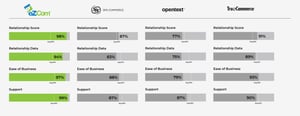Successful Drop Ship Fulfillment
Giant e-tailers like Amazon and Zappos have forever changed the retailing landscape. Consumers expect and demand maximum convenience, lower prices, a wide array of merchandise to choose from, and the ability to get products quickly. With the increasing pressure and fight for market share, more and more traditional retailers are implementing the ‘omnichannel’ model to provide customers the best of all worlds. As these retailers endeavor to seamlessly and efficiently meet the needs of customers at every stage and every touchpoint in the retail process, their supplier partners must support them in order to remain competitive.
A survey recently conducted by Retail Systems Research cites cost effective shipping and fulfillment as one of the top three operational challenges for large retailers. Many retailers are turning to drop ship—a process where vendors ship products directly to customers—to help solve this challenge and create efficiencies.
A well-executed drop ship solution can convey significant benefits to both retailers and suppliers:
- Chance to compete on a more level plane with e-tailers
- Ability to extend product offerings without incurring additional costs and risks
- Higher volume direct-to-consumer capabilities
- Overall enhanced supply chain and higher profits
By demonstrating advanced drop ship capabilities, a supplier can become even more attractive to retailers, giving the company a competitive edge. Plus, drop ship can dramatically increase product distribution and even segue into a stronger presence in retailers’ brick-and-mortar locations.
Although drop ship offers suppliers extraordinary opportunities for growth, this fulfillment method also entails its own unique challenges and compliance guidelines for suppliers. The good news is, with the right tools and partnerships, suppliers can overcome these challenges and realize the immense possibilities.
Suppliers need specific, key, high-volume capabilities to adhere to retailers’ drop ship guidelines in a cost-efficient and time-saving manner:
- Custom branded packing slip – To create a seamless customer experience, most retailers require that their suppliers create a custom packing slip that includes the retailer’s name, logo, address, website, and any additional required information.
- Extremely efficient EDI – Drop ship providers must be able to process many documents quickly in order to save time and money. What used to be a shipment of many items to one destination has now become multiple shipments of one or two items. Batch processing of invoices, ASNs and other documents is crucial.
- Integration tools – If possible, it’s best to work with a platform that can integrate with FedEx and UPS, which saves time and resources while decreasing the margin of error.
- Inventory management and visibility – Integrating warehouse and/or inventory management applications with EDI will further streamline processes and enable suppliers to keep up with the pace of drop ship.
- Special drop ship pricing – EDI services must be priced to ensure the high volume, low quantity model remains profitable.
- Exceptional customer support – To successfully handle high volume, suppliers need EDI customer service teams who provide education and support whenever needed, for as long as needed, until any problems are resolved.
For retail suppliers, drop ship is not just the wave of the future—it’s happening now, and those who excel in direct-to-consumer compliance will come out on top of the game.






